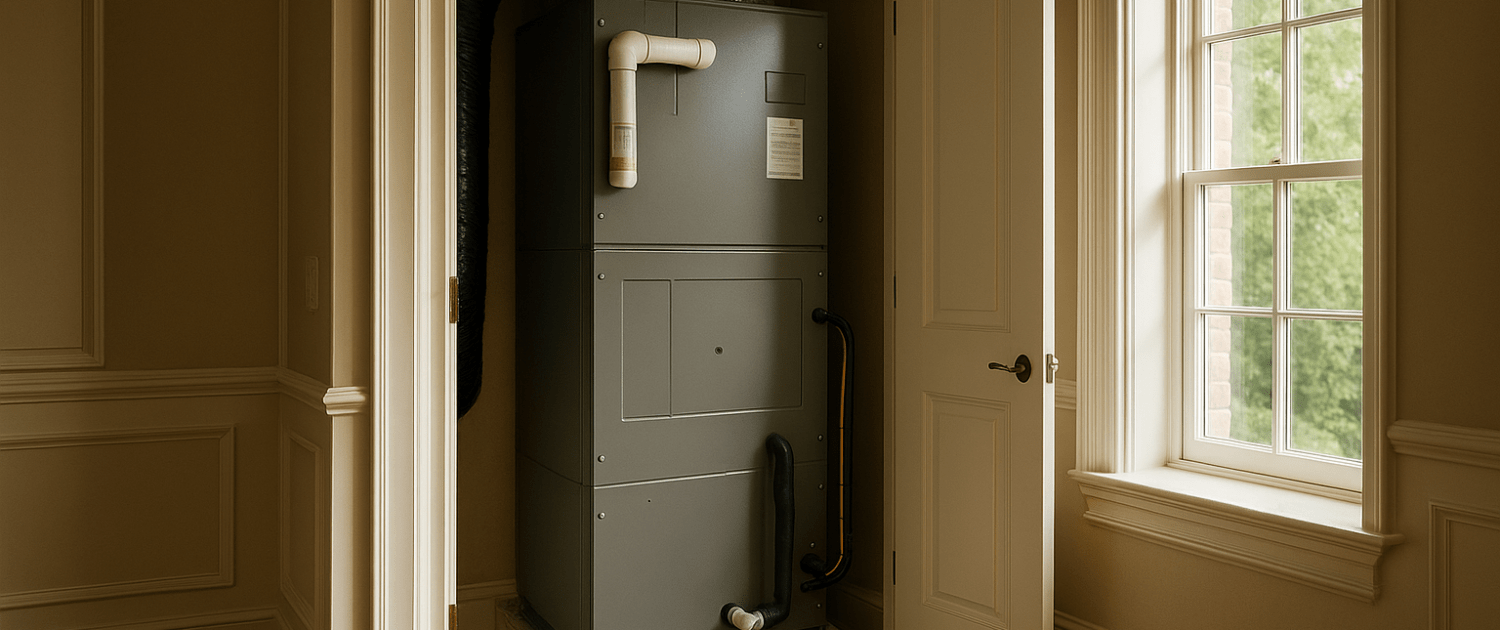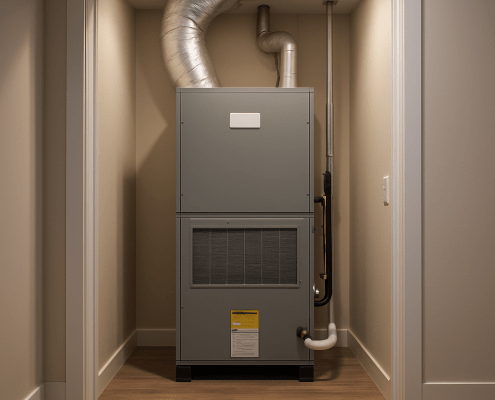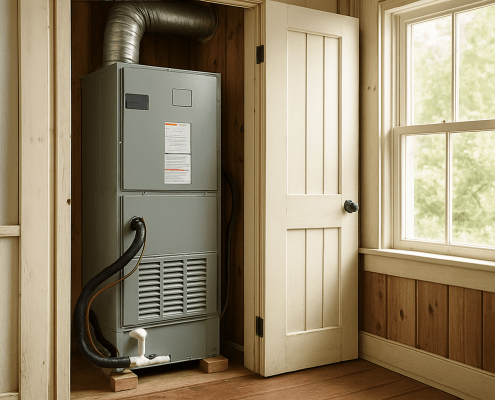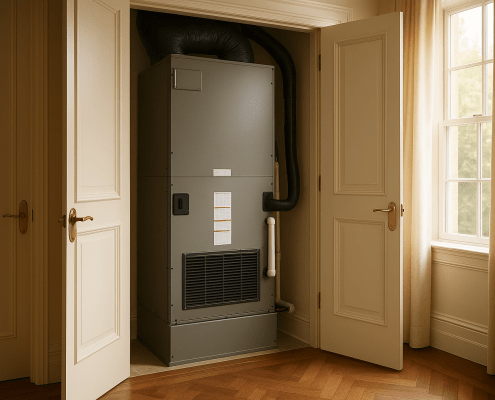Comparing Single-Stage and Variable-Speed Central AC Units
Steven E / Thursday June 26, 2025
When shopping for a new central air conditioning system, you’ll probably come across terms like “single-stage,” “two-stage,” and “variable-speed.” While these may sound like technical jargon, they play a major role in how your system operates, how comfortable your home feels, and how much you’ll pay in energy bills over time.
In this article, we’ll focus on the two most common types of residential systems: single-stage and variable-speed central AC units. We’ll explore how they work, their advantages and drawbacks, and which one might be the best fit for your home and budget.
Whether you’re replacing an old unit or installing AC for the first time, understanding the differences between these two systems can help you make a smarter, more cost-effective decision.
The information in this article may not apply to your specific appliance model. We recommend consulting your manufacturer’s documentation or contact us with any questions.
Understanding the Basics
Let’s start with a quick breakdown of what each type means:
Single-Stage AC Unit
This is the most basic type of system. It has only one level of operation: on or off. When the indoor temperature rises above the thermostat setting, the system kicks on at full blast. Once it reaches the desired temperature, it shuts off completely.
Variable-Speed AC Unit
This type uses a compressor and fan motor that can run at different speeds, anywhere from around 30% to 100% of capacity. Instead of cycling on and off, it adjusts its output in small increments based on your home’s cooling needs.
Now that we’ve defined the two types, let’s cover the pros and cons of each system.
Pros of Single-Stage Central AC Units
- Lower Upfront Cost. Single-stage systems are the least expensive to buy and install. If you’re on a budget or replacing an older system in a starter home, this may be the most accessible option. These systems are widely available and often easier to find in stock.
- Simple Design and Maintenance. Fewer moving parts and basic controls make single-stage units easier and cheaper to service. Many HVAC technicians are well-versed in working with them, and replacement parts are usually inexpensive.
- Works Well in Mild Climates. If you live in an area that doesn’t experience extreme heat for long stretches, a single-stage system may do the job just fine. It turns on when you need it and shuts off when you don’t, simple and effective in temperate zones.
Cons of Single-Stage Central AC Units
- Less Energy Efficient. Since it always runs at full capacity, even when only a little cooling is needed, a single-stage unit can use more electricity than necessary. This inefficiency can lead to higher energy bills, especially in hotter climates.
- Inconsistent Comfort. The on/off operation can cause temperature swings. You might feel a blast of cold air, then notice the house warming up before the AC turns on again. This cycling can also make humidity control less precise, leaving your home feeling a bit sticky.
- Shorter Run Time, Less Air Filtration. Because the system only runs in short bursts, your home’s air isn’t being circulated and filtered as often. That can impact indoor air quality and may not remove humidity as effectively as a system with longer, slower cooling cycles.
Pros of Variable-Speed Central AC Units
- Superior Energy Efficiency. Variable-speed systems adjust their output based on real-time needs. On milder days, they might run at 40 or 50% capacity instead of 100%, using far less energy. This can result in significant savings on your utility bills over time, often enough to offset the higher upfront cost.
- Consistent Indoor Temperature. These units cool your home gradually and evenly, maintaining a steady temperature throughout the day. No more hot and cold spots or sudden blasts of cold air. It’s a more comfortable and refined experience overall.
- Excellent Humidity Control. Because they run at lower speeds for longer periods, variable-speed units are much better at removing moisture from the air. This is especially important in humid regions, where controlling indoor humidity can improve comfort and prevent mold or mildew.
- Quiet Operation. Lower operating speeds mean less noise. Instead of a loud, sudden startup, the system runs more quietly and ramps up gradually when needed. This can be a big plus if your outdoor unit is near a patio or bedroom window.
- Longer System Life. With fewer on/off cycles and more consistent operation, variable-speed compressors tend to experience less wear and tear. That can translate to a longer lifespan for the unit, especially with regular maintenance.
Cons of Variable-Speed Central AC Units
- Higher Initial Cost. These systems cost more to purchase and install than single-stage models, sometimes significantly more. You’ll also want to pair them with a compatible smart thermostat and possibly a variable-speed furnace or air handler, which adds to the total investment.
- More Complex Repairs. Variable-speed systems use advanced electronics and proprietary parts, which can be more expensive and complicated to repair. Not every HVAC technician is trained to service them, and not all replacement parts are readily available in every market.
- May Be Overkill in Cooler Climates. If you live in a region with mild summers and only need cooling a few months of the year, the benefits of variable-speed operation may not justify the higher upfront cost. A well-maintained single-stage system might be all you need.
Which One Should You Choose?
Choosing between a single-stage and a variable-speed central AC system depends on several factors, including your budget, location, and comfort preferences.
Here’s a quick breakdown of who each type of system is best for:
Choose a Single-Stage Unit If:
- You’re on a tight budget and need a simple, reliable system.
- You live in a moderate climate without long stretches of extreme heat.
- You don’t mind slight temperature swings or basic performance.
- You plan to sell your home soon and just want to replace an old unit.
Choose a Variable-Speed Unit If:
- You want maximum energy efficiency and lower long-term operating costs.
- You live in a hot or humid climate where consistent cooling is essential.
- You’re sensitive to indoor air quality, noise, or humidity.
- You plan to stay in your home long enough to benefit from the investment.
- You already have or plan to install a smart thermostat and compatible air handler.
Middle Ground: Two-Stage Systems
If you’re not sold on either extreme, consider a two-stage AC system. These units operate at full capacity during the hottest days but can also run at a lower setting (usually around 70%) the rest of the time. They strike a nice balance between performance and price, offering better comfort than single-stage models but without the higher cost and complexity of a variable-speed system.
Two-stage systems are ideal for homeowners who want improved efficiency and comfort without going all-in on top-tier technology.
Final Thoughts
When it comes to central air conditioning, there’s no one-size-fits-all solution. Both single-stage and variable-speed systems have their strengths and trade-offs. The right choice comes down to your climate, budget, and expectations for comfort and efficiency.
If you’re replacing an older unit on a tight budget, a single-stage system may still be a perfectly good option. But if you’re planning to stay in your home for years and want the most comfortable, energy-efficient experience, a variable-speed system can be a wise investment.
Just remember that proper installation and regular maintenance are key, no matter which system you choose. A poorly installed high-end system won’t perform well, and a budget system can run smoothly for years if it’s taken care of.
Evaluate your home’s needs and make the choice that brings you the best balance of comfort, cost, and confidence.
Where To Find Us
If you need any replacement parts for your appliances, you can enter your model number at AppliancePartsPros.com to locate and order them quickly. Most orders arrive in just two business days, and we have tons of great information in our repair help section and YouTube videos to help you troubleshoot.
Stay connected with the latest DIY tips, tutorial videos, and repair guides by following us on Facebook, Instagram, and Twitter. We love hearing about your repair stories and successes. If you need more help or want personalized guidance, feel free to reach out. We’re ready to help you take on your next project with confidence!
With nearly a decade of experience in providing top-notch customer service regarding appliance parts and repair, Steven enjoys sharing practical advice, troubleshooting tips, and interesting information to help readers stay informed.





